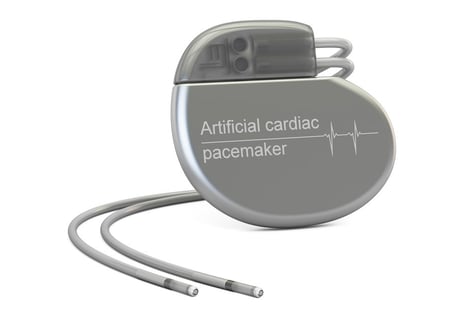Introduction
A pacemaker is a small medical device that's implanted in the chest to help regulate the heartbeat. It’s typically used for people whose hearts beat too slowly, too irregularly, or who experience other types of abnormal heart rhythms (arrhythmias). The device sends electrical signals to the heart to prompt it to beat at a normal rate.


How it works
The pacemaker generates electrical impulses that stimulate the heart to beat at a regular rhythm. It is placed under the skin, just below the collarbone. The device consists of two main parts:
Pulse Generator: The power source, which houses the battery and the circuitry to generate electrical impulses.
Leads (or Wires): Flexible wires that carry electrical signals from the pacemaker to the heart.
The pacemaker continuously monitors the heart’s rhythm. If the heart rate drops too low or if the rhythm becomes irregular, the device sends electrical impulses to stimulate the heart to beat normally. The impulses are mild and painless for the person.
Pacemakers are used for conditions where the heart beats too slowly (bradycardia), too fast, or in an irregular pattern. Common conditions include:
Sick sinus syndrome: A condition where the sinus node (the heart's natural pacemaker) doesn’t work properly.
Atrioventricular (AV) block: A condition where electrical signals between the upper and lower chambers of the heart are delayed or blocked.
Heart failure: In some cases of heart failure, a pacemaker is used to help improve the heart's efficiency.
Types of Pacemakers:
Single-Chamber Pacemaker: This has one lead that’s placed either in the right atrium or the right ventricle. It’s used when only one chamber of the heart needs to be paced.
Dual-Chamber Pacemaker: This has two leads, one for the right atrium and one for the right ventricle. It helps coordinate the timing between the atrium and ventricle for more efficient heartbeats.
Biventricular Pacemaker (CRT - Cardiac Resynchronization Therapy): This is used for people with heart failure and helps the ventricles beat more in sync with each other to improve pumping efficiency. It uses three leads (right atrium, right ventricle, and left ventricle).
Who Needs a Pacemaker?
Pacemakers are recommended for people with:
Bradycardia (slow heart rate)
Heart block (when electrical signals are delayed or blocked)
Atrial fibrillation with slow ventricular rates
Heart failure with ventricular dyssynchrony (CRT)
Certain arrhythmias (especially life-threatening ones requiring ICD)
Implantation Procedure:
The procedure to implant a pacemaker is generally quick and minimally invasive. It’s typically done under local anesthesia, and the pacemaker is placed just beneath the skin, near the collarbone. The leads are threaded through veins into the heart. The whole procedure usually takes 1 to 2 hours, and patients can often go home the same day or after a short observation period.
Post-Implantation Care:
After the pacemaker is implanted, there are some lifestyle and activity guidelines to follow:
Follow-up appointments to check the device’s function and the heart’s rhythm.
Avoid heavy lifting or strenuous exercise immediately after the procedure to allow the leads to settle.
The pacemaker's battery typically lasts 5-15 years, after which it will need to be replaced.
Possible Risks and Considerations:
While pacemaker implantation is generally safe, there are some risks, including:
Infection at the implant site.
Blood clots or bruising.
Damage to blood vessels or the heart during lead placement.
Pacemaker malfunction, though this is rare.
Patients with pacemakers also need to be mindful of certain devices and technologies that could interfere with the pacemaker, like strong magnets or some medical equipment. However, most everyday activities like traveling, using cell phones, and exercising are safe after the pacemaker is implanted.
